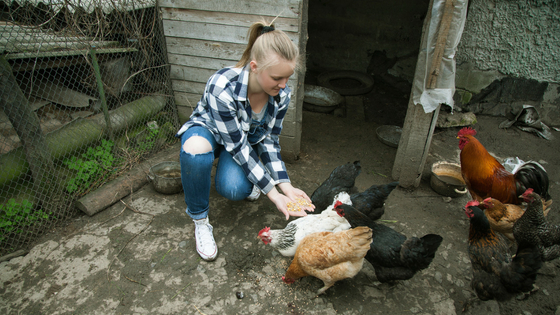One of the joys of keeping a backyard flock of hens is learning that most people are wrong about chickens.
Ask most folks what they think of chickens and they’re likely respond that they are simple minded, smelly creatures useful only for producing tasty meals. But keep a small flock, watch them closely, and the truth emerges. Chickens are intelligent, sensitive birds that behave in intriguing ways. They are individuals. Every chicken behaves a little differently than her coop sisters and collectively they make wise decisions.

To carefully observe chicken behavior, it helps to have a diverse flock of several breeds. Hens with assorted colors, physiques, and comb types makes it easy to instantly recognize individuals. A Buff Orpington, for example, looks much different from a Silver Laced Wyandotte.
Hoover’s Hatchery makes it easy to develop a diverse flock. A customer can order several breeds of different feather colors or patterns in even small orders. Some people prefer sticking with a single strain of hens, but even within a breed each chicken can be identified as an individual. It takes close observation because at a quick glance the hens look identical, but they will vary slightly. One Rhode Island Red might have a smaller comb or a slightly different shade of feathers than her coop mates of the same breed. Identifying each bird in the flock as an individual makes it possible to spot behavioral variations.
Some interesting aspects of chicken behavior that a small flock owner might notice by careful observation include:
Roost mates. Chickens often prefer to roost near or next to the same coop mate every night. For example, a Barred Rock may be spotted sleeping next to the same Australorp night after night.
Different drummers: Some hens just plain act differently than their companions. An individual hen may not follow the flock. For example, an Americana might stay perched on the roost looking around when all the other hens race to devour mealworms scattered as treats. Just like people, every hen acts a little differently from the others, and some are very different. Chickens aren’t clones. Every bird is an individual.
The brassy and the meek: In any flock it’s likely that one or two birds are aggressive while one or two others are unassertive. This is tied the well-known “pecking order” and is easy and fun to observe.
Heat and Cold: Like humans chickens prefer moderate temperatures. When the heat and humidity become overpowering, chickens find solutions. They’ll hunker down in the run’s cool earth or enjoy the shade under a bush. But when January’s deep chill arrives they’re sunbathers enjoying warming sunbeams streaming through the coop’s window. When the temperature drops to arctic levels hens often abandon roosting and tuck themselves into nest boxes for the night. It helps them retain body heat.
Partners: Every once in a while, a hen suffers a minor injury or slight illness. She’ll be lethargic for a few days, often sitting still in the coop or run. Sometimes a partner will join her and sit beside her for hours as if she’s a friend encouraging the ailing bird.
Enthusiasm: Enter the coop with tasty kitchen scraps or a scoop of mealworms and one or two birds will lead the flock in their enthusiasm to be the first to dine on the tasty tidbits.
Learners: Chickens learn quickly. Use the same bucket or bowl to deliver tasty kitchen scraps to the flock and they’ll come running every time they see the bucket or bowl.
The brave and the timid: Curiosity seems to motivate some chickens. They’ll be the first to investigate something new in the coop or run. They’ll test a new treat first and often will approach a human carrying the treat bucket with what appears to be friendly curiosity. Other hens are downright wary. They’ll stay back and let their flock mates try a treat first. They’ll also meekly avoid human caretakers.
These are just a few common chicken behaviors. Watch a flock closely and there’s plenty the hens will teach a curious person. It’s one of the joys of chicken keeping.